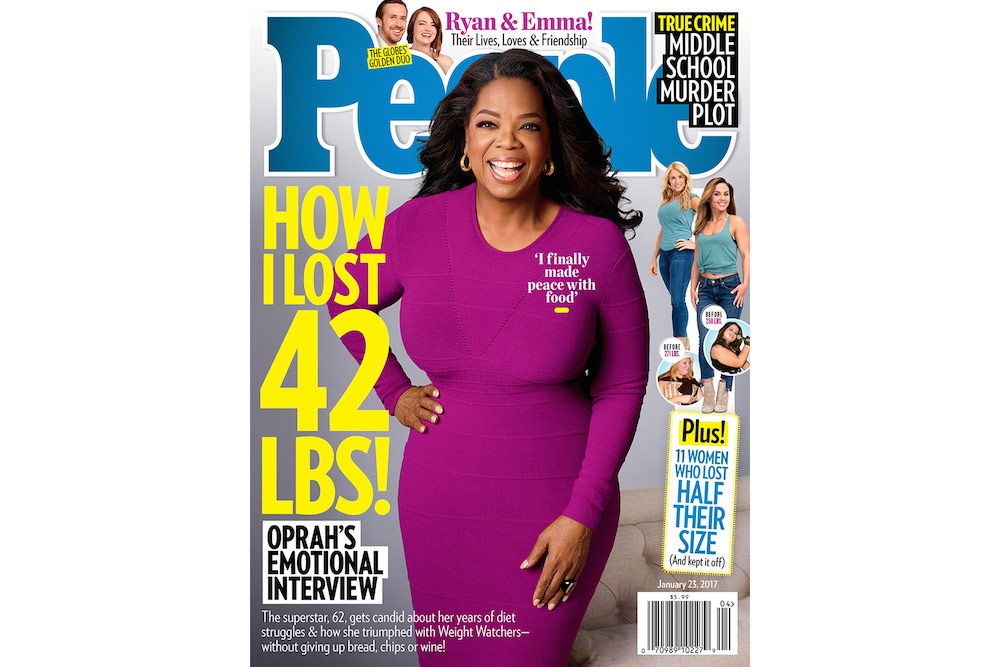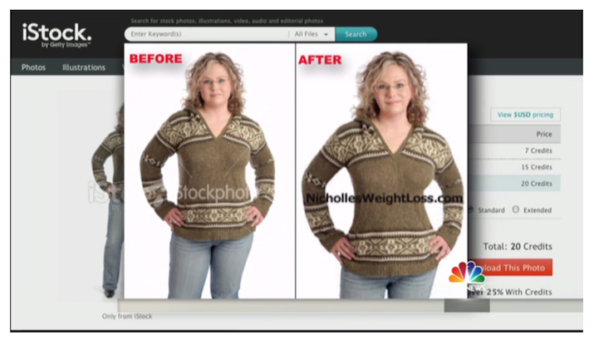Using Weight-Loss Ads to Teach Media Literacy
A MiddleWeb Blog
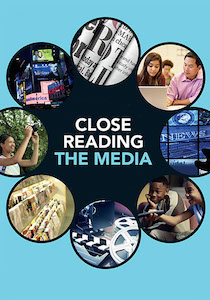 If you’re reading this in January, you’re probably already getting inundated by promises to remove the fat without sacrificing the calories or breaking a sweat. After the holidays, the weight-loss/diet industry bombards consumers (including susceptible tweens and teens) with messages on radio, television, and the web.
If you’re reading this in January, you’re probably already getting inundated by promises to remove the fat without sacrificing the calories or breaking a sweat. After the holidays, the weight-loss/diet industry bombards consumers (including susceptible tweens and teens) with messages on radio, television, and the web.
They know that many of us overindulged during the holidays, and they’re making promises (from the subtle to the outlandish) that you can take that weight off fast. But can you? And can you believe everything they say? A little healthy skepticism goes a long way. That is what “media literacy” is all about.
And it’s not just ads in the media. Magazine covers, many aimed at the female demographic, are on newsstands now. People Magazine, for example, always uses a January issue of the New Year to tout celebrity and real-people diets and weight-loss advice, as it did in this January 27, 2017 edition with Oprah Winfrey on the cover touting her Weight Watchers diet (click to enlarge).
The Federal Trade Commission (FTC), which oversees advertising, had some very good advice for consumers in this press release: “If you see an ad for a weight-loss product making fantastic claims, keep your money in your pocket.”
Fantastic promises are not hard to find. “The easiest diet ever” claims one product; “I lost 89 pounds” says another. Even though this sounds attractive and appealing, can it possibly be true? “Testimonials from individuals are not a substitute for science, and that’s what Americans need to understand,” said an FTC chair quoted in the news back in 2007.
To help consumers better cut through the hype, in the early 2000s, the FTC created a report titled “Red Flag: Bogus Weight Loss Claims.” Using dramatic imaging and bold red pennants, it warned people about the deceptive advertising, offering some strong advice:
Misleading weight loss advertising is everywhere, preying on consumers desperate for an easy solution. There is no magic bullet when it comes to losing weight. Claims for diet products that promise weight loss without sacrifice or effort are bogus, and in some cases, dangerous.
The FTC updated the “Red Flag” document in 2014 for a different audience: publishers and TV advertising executives. The new report, titled Gut Check: A Reference Guide for Media on Spotting False Weight-Loss Claims, describes seven weight loss claims that can’t be true and should prompt a “gut check” – “a second look to make sure publishers are not running advertisements with claims known to be false.”
The FTC said advertising was false if it claimed a product:
- causes weight loss of two pounds or more a week for a month or more without dieting or exercise;
- causes substantial weight loss no matter what or how much the consumer eats;
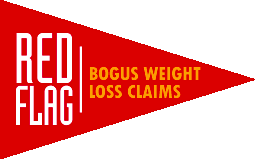 causes permanent weight loss even after the consumer stops using product;
causes permanent weight loss even after the consumer stops using product;- blocks the absorption of fat or calories to enable consumers to lose substantial weight;
- safely enables consumers to lose more than three pounds per week for more than four weeks;
- causes substantial weight loss for all users; or
- causes substantial weight loss by wearing a product on the body or rubbing it into the skin.
The guide also contained advice on dealing with problematic areas like consumer testimonials and fine print disclosures. As the FTC also noted, those before-and-after photos can be highly manipulative. Have you noticed how unhappy the people (usually actors) are and how poor their posture is in the before photos – but how happy and attractive they look in the after?
And then there are the “photoshopped” images of celebrities, endlessly tweaked by graphics designers to remove every blemish and sculpt perfect, fat-free bodies. (Does anyone think the Kardashians ever looked quite like they are portrayed?)
A few years ago, NBC’s Today Show did a special report on deceptive before-and-after photos that included an example of a German plus-sized model (above) whose image has been altered many times under many fake names to promote various weight-loss products.
Activity: Diet Ads in the Classroom
So what does this annual avalanche of diet advertising mean to you, the classroom teacher? Use it as yet another “media literacy” teachable opportunity, while also sharpening critical thinking skills.
 ► Look for weight-loss ads to share with students. You won’t have any problem locating some in many of the magazines you come across during January (and beyond). You can also do a simple Google image search for “diet advertising” and turn up a virtual history of diet ads dating back to the 1950s (like the Domino Sugar ad at right). The NBC Today Show video mentioned above is also a great teaching tool.
► Look for weight-loss ads to share with students. You won’t have any problem locating some in many of the magazines you come across during January (and beyond). You can also do a simple Google image search for “diet advertising” and turn up a virtual history of diet ads dating back to the 1950s (like the Domino Sugar ad at right). The NBC Today Show video mentioned above is also a great teaching tool.
► Consider using some of this material to teach students not only about persuasive techniques, but also argumentative writing – an important Common Core standard. As this blog post explains, the CCSS expects students to learn how to argue in writing using reasoning and evidence. Applying these standards of argument to diet advertising quickly reveals the difference between persuasion and argument. (This chart from the ReadWriteThink website can help.)
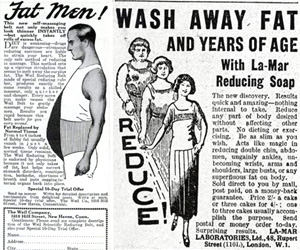 ► Have students identify audience, purpose, wording, and visual and audio techniques. This handy two-page document offers good advice for deconstructing print ads. In this lesson plan at my website, there is timely advice as well, and a series of questions your students can use that will help them identify the key elements in commercials.
► Have students identify audience, purpose, wording, and visual and audio techniques. This handy two-page document offers good advice for deconstructing print ads. In this lesson plan at my website, there is timely advice as well, and a series of questions your students can use that will help them identify the key elements in commercials.
► Consider the covers of magazines as content to be studied also. Since the Common Core standards position our students as “reading detectives,” they should be developing the basic skills to observe covers for layout, design, color, and more, and then provide evidence to prove the intent of the editor. Look over this standards-based lesson plan by school media specialist Debra Bumgarner, “Using Magazines for Media Literacy” for inspiration.
Additional resources
• Gut Check: A Reference Guide for Media on Spotting False Weight Loss Claims (Federal Trade Commission)
• Activity Sheet: Argumentative vs. Persuasive Writing (Empowering Writers)
• I have also created a collection of diet ad resources at my website. I invite you to peruse it and consider how it can help you engage your students in some of the most powerfully persuasive messages out there today.
_____________
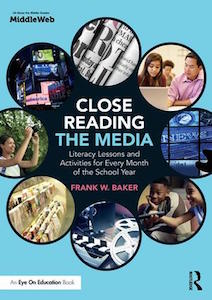 Adapted from Frank Baker’s new book Close Reading the Media: Literacy Lessons and Activities for Every Month of the School Year (2018). Published by Routledge/Eye on Education in partnership with MiddleWeb. Readers of this post can receive a 20% discount by using the code MWEB1.
Adapted from Frank Baker’s new book Close Reading the Media: Literacy Lessons and Activities for Every Month of the School Year (2018). Published by Routledge/Eye on Education in partnership with MiddleWeb. Readers of this post can receive a 20% discount by using the code MWEB1.

